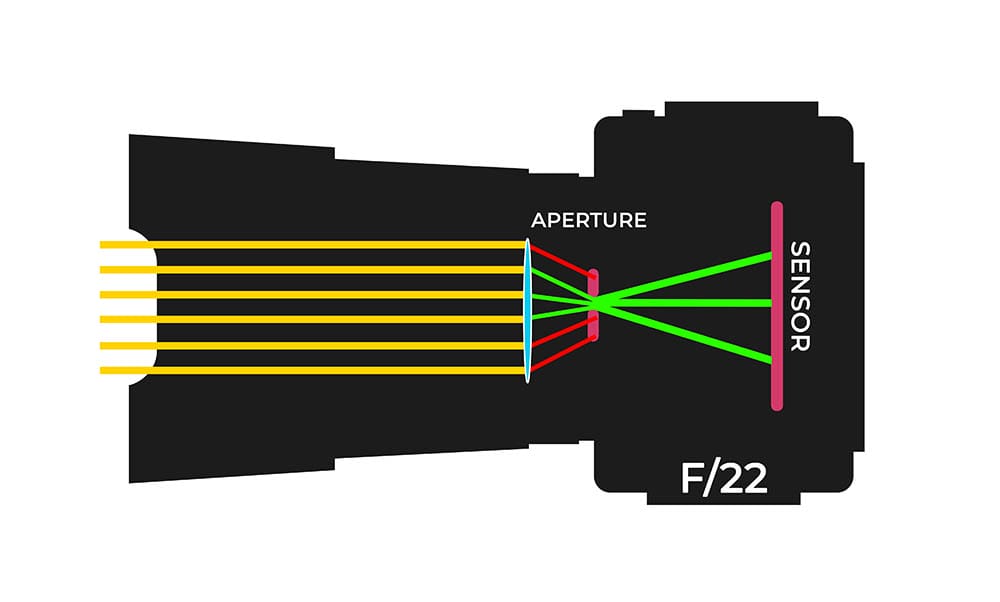In the world of photography, capturing sharp and detailed images is a top priority for many photographers. However, a phenomenon called diffraction can sometimes hinder the achievement of ultimate image quality.
In this article, I will delve into the concept of diffraction in photography, exploring its causes, its impact on photographs, the types of camera lenses that can cause diffraction, and most importantly, how to minimise its effects to create stunning images.
Diffraction is a phenomenon that occurs when light waves meet an obstacle or an aperture, causing them to bend and spread out. In photography, it refers to the bending of light as it passes through the aperture of a camera lens.
While diffraction is a fundamental property of light, it can have undesirable effects on image sharpness and clarity when it exceeds certain limits.

Diffraction in photography is primarily caused by the physical properties of light and the characteristics of camera lenses. When light passes through a small aperture, such as the iris diaphragm of a lens, it undergoes diffraction due to the wave nature of light. The smaller the aperture, the greater the diffraction effect.

Diffraction affects the overall sharpness and resolution of an image. As light waves diffract, they spread out and interfere with each other, leading to a loss of minute details and reduced contrast.
This effect becomes more prominent as the aperture is narrowed, affecting images captured at higher f-numbers (smaller apertures) more severely. Diffraction can make images appear soft, lacking in detail, and less visually appealing.


Diffraction can occur with any camera lens, but it becomes more noticeable with lenses that have smaller largest apertures. Typically, lenses with higher magnification, such as telephoto lenses, tend to have smaller largest apertures and are more prone to diffraction.
Additionally, compact point-and-shoot cameras and smartphones with small lens apertures can also show noticeable diffraction effects.
While diffraction cannot be eliminated, there are techniques to minimise its impact and maximise image sharpness. Here are a few tips to help you avoid diffraction in your photography:
Avoid using extremely small apertures (high f-numbers) unless necessary. Choose a wider aperture (lower f-number) whenever possible to reduce the effects of diffraction while keeping a suitable depth of field.
Every lens has an aperture range where it performs at its best, commonly referred to as the “sweet spot.” This is usually a couple of stops down from the lens’s largest aperture. Experiment with your lens to find its best aperture for best sharpness while minimising diffraction.
Utilise hyperfocal distance techniques to achieve a desired depth of field without needing to stop down the aperture excessively. This allows you to keep sharpness throughout the scene while avoiding the smallest apertures that can induce diffraction.
When using neutral density (ND) or polarising filters, make sure they are of high quality and avoid stacking multiple filters. Poor-quality filters or stacking can introduce added optical elements that may increase the likelihood of diffraction.
In post-processing software, apply selective sharpening techniques to enhance image details and compensate for any loss of sharpness caused by diffraction. However, be cautious not to over-sharpen, as it can introduce artifacts and degrade image quality.


Image: Comparison of the same subject capture at the widest and narrowest aperture of the same lens. Which looks sharpest to you?
Diffraction is an inherent characteristic of light that affects the quality of photographs, particularly when using smaller apertures. While it cannot be eliminated, understanding how diffraction occurs and its impact on image sharpness allows photographers to make informed decisions when choosing their camera settings.
By applying best aperture choice, finding the lens’s sweet spot, utilising hyperfocal distance, using high-quality filters, and employing post-processing sharpening techniques, photographers can minimise the effects of diffraction and capture stunning, sharp images that highlight their creative vision.
Remember, photography is a balance between creative choices and technical considerations. By mastering the intricacies of diffraction and employing the right techniques, you can elevate your photography to new heights and produce images that leave an impression on viewers.
Discover TOP features in the Lightroom CC mobile app with this guide for enhancing your photo editing skills. For desktop and tablet too.
Shooting sunsets using amazing 5-in-1 magnetic lens filters from Kentfaith, the 1st choice for photo & video products.
Popular memory cards for photography – what’s the best SD card for your digital camera? Choose the right capacity and class speed in our guide
Learn the basics of photography – fast – with our FREE 60-Second Photographer online course. Each class is short and sharp with simple, actionable steps that give you immediate results.
x 30 lessons

© iPhotography™
Become a confident and competent photographer in less than 30 minutes!
Before you leave, make sure you’ve secured your FREE online photography course (worth £29.99)
Each class is just 60-seconds or less making it the fastest and easiest way to learn photography!